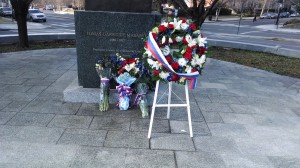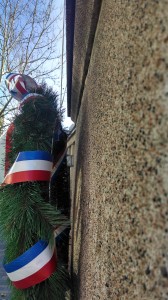I meant to make this post available well ahead of Memorial Day, but that obviously did not happen. There will always be another occasion for wreaths and tributes at monuments, though.
But it wasn’t a national holiday that made me think about this subject originally. I live in Washington D.C., and live near several memorials to foreign luminaries. Embassies and ex-pats will often leave flowers in tribute, so I see a lot of these. And then there are the wreaths and other flowers left at the military memorials. Florists must do well around here.
But not all choices are equally good. Here are some ideas if you intend to leave a wreath or make a floral presentation at a public monument.
If I had to pick one action, plan for someone to clean up the wreath-remains within a few days. A pile of compost isn’t a tribute.
After that, choose the backing (and if needed, easel) well. The Ukrainian embassy left a wreath for the Schevchenko bicentennial earlier this year — in the context of a national crisis no less — but the flowers were attached to a plastic (think bread wrapper) covered foam hoop. Worse, it was too heavy for the wire easel, and with a slight breeze it toppled over and broke.

I found it broken I was out walking Daisy the Dog, but it was past re-staging.
Contrast this with a wreath the Slovak embassy left on the birthday of the first Czechoslovak president (and husband of American-born Unitarian, Charlotte Garrigue) Tomáš Garrigue Masaryk. The papier mache is stronger, so the wind did not destroy it, and the wooden easel adds dignity.

Or do without the easel, and mount the wreath with this tribute to the Madonna of the Trail, in suburban Bethesda. The coated wire provides a backing to hang the wreath. (And now I can imagine where the typical toothmarks of decay on old sandstone monuments comes from…)







